#cienie's sidenotes
Explore tagged Tumblr posts
Text
Cienie's Sidenotes: Human Mandalorians or vassals? (Pre-Mandalorian Wars era)
Up to the Mandalorian Wars, humans living on planets like Concord Dawn and Gargon, were part of Mandalorian society yet fulfilled the role of vassals to their Mandalorian (Taung) overlords, as was stated in "Industry. Honor. Savagery: Shaping the Mandalorian Soul” [The Essential Guide to Warfare, 2012]:
The Jakehans, for one, welcomed their new Mandalorian overlords, as did knots of worlds populated by humans centered on Concord Dawn and Gargon. Those worlds—along with the likes of Hrthging, Breshig. Shogun, and Ordo—became part of Mandalorian Space.
Bounty Hunter Code implies too that humans were officially accepted into Mandalorian ranks thanks to Mandalore the Ultimate and the Great Adoption:
“Of the ancient Mandalores, we hold none in higher esteeem than Mandalore the Ultimate, the Great Shadow Father of our clans. On Shogun, then as now planet of visions, Mandalore the Ultimate received a staggering prophecy: The age of Taung was ending, but their great work was unfinished. To survive, the Mando’ade must be transformed. It was a terrible burden, but Mandalore the Ultimate bore it with honor. He opened the clans to all who proved themselves in battle and followed the warrior code. Non-Taung were no longer confined to vassalship, but could be full-fledged Mandalorian warriors. Our forefathers were among these new Mando’ade, and soon proved that they were ready to lead the clans.”
The History of the Mandalorians (2005) also notes the "ethnic" uniformity of the original Mandalorians
"Though in modern times the Mandalorians have became a grab-bag of alien races, including humanoids, Togorians, and Kerestians, the Mandalorians were once strictly a gray-skinned warrior race. Xenoantropologists believe that this original Mandalorian species was descended from the ancient Taung Shadow Warriors of Dha Werda Verda legend."
and non-Taungs - beside Mandallian Giants - were just accepted and treated as equals in the period between Sith War and Mandalorians Wars.
"[...] the temporary defeat precipitated a frenzied conviction that the "Great Last Battle" was at hand. For 20 years, the Mandalorians zealously invaded small non-Republic worlds on the fringe of Known Space, raiding their resources and building up a powerful army. Anticipating an apocalyptic war, the Neo-Crusaders began accepting members of other species into their midst, treating these "converts" as equals."
However, Knights of the Old Republic Campaign Guide suggest that humans, like Ordo Canderous, fought in the Sith Wars already as Mandalorian Crusader - albeit Canderous himself would be pretty young from what I gathered about his history. In the KotOR game in one of his dialogues Ordo proclaimed “I've been fighting across the galaxy for 40 of your years” and the game was set in 3956 BBY. The Mandalorian Wars ended four years before, in 3960 BBY. The Sith War ended in 3996 BBY. The time difference between Sith War and the events of the game adds up to 40 years (and whether Ordo stated exact amount or rounded number, is up to debate). So even if his fighting experiences dated back to the Sith War, he would rather be a novice warrior than a seasoned veteran. Additionally, The History of the Mandalorians states that Ordo Canderous was "recruited or "converted" to Mandalore's the Ultimate's cause during Mandalorian Wars, where he was among those to serve as a battle tactician rather than a foot soldier. What confirms Ordo's great skills/war experiences in the later conflict, yet implies the not-equal status during Sith War.
At the same time, as Taung were already dying species, it makes sense to enlist human members of Mandalorian clans as additional troopers, as vassals usually are bound to support their lords in time of war. There is also a possibility that humans living in Mandalorian clans were naturally assimilated into culture through the ages - if they were considered to be part of Mandalorian society each human wishing to earn the warrior rank should only need to prove themselves in fight to gain Taungs’ recognition as Taungs in general didn’t care for species, only for skills, loyalty to clan and Mandalorian creed (honor).
This is especially important as the Crusaders (traditional Mandalorians) did not proselytize people around them,as was stated in KotOR Campaign Guide:
The traditional Crusaders do not proselytize; rather, they attract others to their cause throught the examples they set. Veterans see the later Neo-Crusaders movement, which actively converts outsiders in its hurry to conquer the galaxy, as a perversion.
which suggests the will to join warrior ranks needed to come from an individual human/non-Taung - and who knows, maybe those who didn’t want be warriors were simply allowed to life in peace as farmers, blacksmiths, artisans and any other job that supported the warrior culture of their Taung lords? Especially since some Mandalorians are known under the Fett surname (originally written as Vheff) and the word means literally a farmer. In contrast, the Mandalorian movement known as Neo-Crusaders that started in the period between Sith Wars and Mandalorian Wars and who became the majority part of Mandalore the Ultimate’s army actively converts humans and Aliens alike to warrior culture, even against their will, as could be seen in Knights of the Republic and KotOR:War comics series.
Thinking about the issue more, in those two mentioned comics, only Mandalore the Ultimate is recognized as Taung in tie-in materials, so the Neo-Crusader movement may be itself a result of the Great Adoption (change of traditional laws?) and made by former vassals who spread the culture further than Taungs would normally did.
Personally I like to think that individual human members of Mandalorian clans could earn the warrior title before Sith War, especially since humans (vassals) slowly grew into numbers while Taung species was dying out. This may be supported by Knights of the Old Republic Campaign Guide that states:
“The traditional Mandalorian Crusader - from the days before the Neo-Crusader movement - lives like his ancestors. Many are born into the clans. The majority are Human, although members of the Taung species remain, as well as some alien converts.”
My conclusion at this moment is that the relationship between human vassalship and Taung lords naturally grown into clan dynamic between those two groups and those who proved themselves in battle earned the respect of Mandalorian warriors yet from a legal point of view and/or commonly recognized customs there still was a distinction between Taungs and human members of the society, at least until Mandalore the Ultimate officially abolished the division by opening the rank to anyone willing to join.
This could also affect the type of weapon and its dependence on social status. Thus the right to carry traditional and/or ceremonial Mythosaur axes could be for some religious or social reason restricted solely to Taungs (especially the experienced warriors?) and that is why we do not see officially recognized non-Taung carrying mythosaur ax, beside Ulic Qel-Droma while dueling Mandalorian the indomitable.
Of course, there is not enough data to make a proper analysis of the social-economy situation of human vassals and those voluntarily converted to warrior religion. However the mass indoctrination to Mandalorian Way for sure happened during Neo-Crusaders era which was the starting point for human dominance that lasted to modern time, as now there are few Aliens in Mandalorian ranks, while axes (Taung traditional weapons) gave way to swords more commonly used by humans, like Darksaber or beskad (sword made out of mandalorian iron).
#star wars#cienie's research#cienie's take on mandalorian culture#cienie's sidenotes#i was going put in in main text about kad ha'rangir but then decided to divide the monster-meta in smaller pieces#so i guess i'm gonna stick to the humans officially were accepted into mandalorian rank thanks to mandalore the ultimate#and those who gained the title of mandalorian warrior before that did it on their own and may not be the norm
7 notes
·
View notes
Text
Cienie's take on Mandalorian Culture: Arasuum, the God of Death, not Sloth #2
The Funeral Rites of Taungs and later Mandalorian Warriors. <> Kad Ha’rangir and Mandalorian traditional weapons (part 1 — part 2 — part 3 – part 4 – part 5) <> Arasuum, the God of Death, not Sloth (part 1 — part 2 — part 3 — part 4)
The first part was an introduction to my theory that Arasuum is not the god representing laziness, but death. I based my reasoning on the Mandalorian language that distinguishes between stagnation and laziness, as one word is not derived from another but also pointed out a visible correlation between gods names and their roles, in which laziness does not fit what the sources provided so far for Mandalorian gods. Thus laziness as Arasuum’s attribute seems to me more like modern interpretation than the original meaning behind the myth.
Establishing those two important nuances, it is time to look closely at the source material and their nature. In advance, I must warn that this part is focused on examining the sources as much as the religion itself, as text critical analysis is a natural part of widely understood research.
Keeping in that mind, let’s talk about source material.
Ancient Mandalorians were presented as religious society that once worshiped many gods before the war became a divine itself - the claim dates at least to “History of the Mandalorians” from Star Wars Insider #80, 2005. From 2005 to current day, there are three main sources that influenced fandom’s idea of Arasuum and his role in mandalorian mythology:
Mandalorian: People and Culture [Star Wars Insider #86, 2006]
Industry. Honor. Savagery: Shaping the Mandalorian Soul [The Essential Guide to Warfare, 2012]
Death Watch Manifesto [The Bounty Hunter Code, From Files of Boba Fett, 2013]
The Star Wars Insider’s article was written by Karen Traviss, whose Republic Commando book series shaped and popularized the modern Mandalorians[1]. This piece was published on February 21, 2006, which chronologically predates Republic Commando: Triple Zero, released on February 28, 2006. A lot of presented here ideas were either already part of the author's previous work (Hard Contact book and Omega: Targets short story) or will be exploited more in further novels. Understandably then, Mandalorians: People and Culture is more of an introduction to the world of Mandalorians than an ultimate guide - though a great chunk of presented in article material built the ground for writing of other authors and fans alike, it is hard to miss how it contradicts itself on some vital matters.
The article starts with the opening quote from in-universe “Mandalorians: Identity and Language”, published by the Galactic Institute of Anthropology:
In five millennia, the Mandalorians fought with and against a thousand armies on a thousand worlds. They learned to speak as many languages and absorbed weapons technology and tactics from every war. And yet, despite the overwhelming influence of alien cultures, and the absence of a true home world and even species, their own language not only survived but changed little; their way of life and their philosophy remained untouched; and their ideals and sense of family, of identity of nation, were only strengthened. Armor is not what makes a Mandalorian. Armor is simply a manifestation of an impenetrable, unassailable heart.
This passage gives us a sense of what the Mandalorians are - or rather how they are seen by the unnamed author(s). But this is a very romanticized if not outright idealized description, based more on wishful thinking than a “facts” (lore) itself.
For one, Mandalorians’ way of life did not remain untouched, as they changed from independent military force (Mandalorian Crusaders and Neo-Crusaders) into people mainly engaged in mercenary work due to lost Mandalorian Wars (3976-3960 BBY) and if we include much later New Canon, they changed from warriors to pacifist (738 BBY). Majority of Mandalorians’ inner conflicts were in fact about what Mandalorians should be, because there was no common, universal identity all people could cling to anymore. And yes, the majority of (Legends) Mandalorians saw themselves as warriors, but that was not enough to avoid schisms and civil wars.
To name the major examples, the first real friction happened just before and during the Mandalorian Wars, between traditional Crusaders and the New-Crusaders whose philosophy and purpose deviated from the universally accepted norms. Among those “oddities” was establishing color-themed armors and using them as official ranks or mass-forcing people into the Mandalorian army - something that more traditional Mandalorians like Mandalore the Ultimate or Gummig did complain about through the comics series of KotOR and spin-off sources. The Knights of the Old Republic Campaign Guide (2008) openly states that

The traditional Crusaders do not proselytize; rather, they attract others to their cause through the examples they set. Veterans see the later Neo-Crusaders movement, which actively converts outsiders in its hurry to conquer the galaxy, as a perversion.
After the war, a great number of Mandalorians became mercenaries and Canderous Ordo needed decades to rebuild the sense of warrior honor and reunite scattered Mandalorians under his banner. For his effort, he earned the name Mandalore the Preserver. And yet the discord between warriors following the old traditions and those turning into mercenaries or outright bandits preying on the weaker grew stronger. This cultural shift has never been fully merged back and so three to four centuries later, we have another ideological conflict between Mandalorians, this time those following Mandalore the Avenger (Shae Vizsla) and Heta Kol, the Field Marshal of Hidden Chain. The clash again came down to the mercenaries vs warriors/crusaders mindset that we could sum up with Heta Kol’s quote:
In Shae Vizla, I see only hypocrisy. She has driven out those who oppose her view, yet she has remade the Mandalorians into servants of anyone who pays her enough credits--no matter what they believe. Where is the honor in that?" [The Old Republic game]
Similar conflict happened decades before Clone Wars, between True Mandalorians under Jaster Mereel and later Jango Fett’s leadership and Death Watch led by Tor Vizsla. Depending on the sources, Jaster Mereel either saw Mandalorians just as highly paid soldiers (as stated in Jango Fett: Open Seasons) or brought reforms to bring Mandalorians back to the more honorable ways (as presented in majority of tie-in sources), while Tor Vizsla wished to bring back Mandalorians to their conquering galaxy roots[2].
If we include New Canon, the mandalorian conflict takes even more drastic shape, this time between exiled warriors and those who renounced their war culture for pacifism.
Which proves that in the main historic eras presented in lore, Mandalorians may share the same skills, be part of the same war culture, yet there is no “only right one” identity or philosophy that unites all people and during the inner conflicts, a great chunk of Mandalorians will consider their ideological opponents as “dar’manda”[3], or traitors regardless if they follow cultural norms or not. The Mandalorian style of life has changed and changed in a way that left their culture fractured and torn between seeking independence and rebuilding the Mandalorian Empire or accepting the life of mercenaries or even rejecting both ideologies for non violent, peaceful life.
A similar thing may be said about language, because the way people speak naturally evolves with passing time and is a reflection of their culture and historical period they lived in. For Mandalorian language to remain the same for such a large period of time - five millenia, as quote states - its speakers would need either to die out or at least live in isolation, cut off from the rest of the galaxy. Which in both cases we know is not true.
We need to remember that the post-Mandalorian Wars era is a time in which the original Mandalorians (Taungs) died out, replaced by human and non-human people adopted into culture before and during war. As then-current Mandalore the Ultimate noted himself, Mandalorians faced problems they never before had, including the new wave of recruits and not enough time to teach them their culture:

“So many new recruits. Different species, different armors, different languages - and not enough time to learn our ways”. [Knight of the Old Republic, #20]
Which is a valid reason to assume that original mando’a at some point was influenced by new recruits’ native languages, especially Basic. Because if there was no time or opportunity to teach a mass of people (often forced into the Mandalorian army against their will), then naturally all the gaps in linguistic knowledge will be filled by things “newcomers” actually knew and understood.
Going further, The Mandalorians: People and Culture provides information that:
Mando’a is predominantly a spoken language, and contractions and pronunciation variations occur much as they do among Basic speakers
and that
The infinitive ends in -ir, -ar, -ur, -or, or -er. Removing the “r” usually produces the stem, e.g.: jurir - to bear or carry. Sometimes an apostrophe separates the terminal vowel, to indicate the slight glottal stop of some Mandalorian accents. This apostrophe, known as a beten, or sigh -- as in Mando’s -- can also indicate breathing, pronunciation, or dropped letters. So ni juri kad (I carry a saber) or even ni jur’kad is a correct as ni juri kad in some communities.
or
Spelling and punctuation have optional forms so it’s hard to get it wrong. What other species might take for sloppy grammar, Mandalorians embrace as the right of the individual Mando’ad (son or daughter of Mandalore) to add their own touches to their language, much as they customize their armor.
If we agree that mando’a words can be pronounced however each Mandalorian feels like, then it is natural the language may vary from one speaker to another, and with passing time creating specific dialects for individual clans or even the whole region. For example, Concord Dawn is part of the Mandalorian Sector. The article noted
[Mandalorians] are still predominantly human, and a large percentage of the population shows genetic markers typical of the peoples of Concord Dawn and nearby planets. Although there is no true Mandalorian ethnic type, the prevalence of common gene clusters indicates that specific populations were either absorbed by the Mandalorians or joined them.
and yet, Concord Dawn, despite such historical and cultural strong ties to Mandalorians, has its own dialect[4] that is apparently still close enough to mando’a to be understand by Mandalorians however it has its own distinct words that make communication difficult.
“It wasn't Mando'a, but it was close enough for any Mandalorian to understand”. (Republic Commando: Order 66)
&
Commander Bacara was originally trained by one of the few non-Mandalorian instructors, an ex-Journeyman Protector named Cort Davin from the Concord Dawn system. [...] Bacara found it difficult to converse in Mandalorian with his brethren as he learned the peculiar dialect of Concord Dawn, which used words like “tat” instead of “vod” for “brother”. (Guide to the Grand Army of the Republic, published in Star Wars Insider: 84)
The moon of Mandalore, Concordia, apparently also has its own dialect[5], as mentioned by The Clone Wars in The Mandalore Plot episode:
Satine Kryze: He was speaking in the dialect they use on Concordia, our moon.
A dialect that the Duchess of Mandalore recognized easily and was capable of understanding and speaking it(?).
Additionally, the Complete Star Wars Encyclopedia’s entry for mando’a states:

At its core, Mando’a was a spoken language, because many different groups spoke it with enough subtle variation that writing it down became problematic [...].
As much as I agree it is impressive for Mandalorians to cultivate their culture for millenia despite many historical setbacks (including devastating military defeats) that influenced their political-economic standing in the galaxy, saying that language did not change for such a long period of time is both wrong and surprising for an in-universe academic claim officially published by the Galactic Institute of Anthropology.
I assume the author’s intent was to praise Mandalorian’s unshakable sense of identity. However, looking at it from the perspective of time and expended lore, this statement puts into question not Mandalorian history but the Republic (galactic)’s knowledge about the Mandalorians. It does not help that we have no time frame in which the in-universe academic text was written, as in how out-dated could be the source.
The main part of the Mandalorians: People and Culture is not free of inconsistency and some parts contradict each other within the same article. This is the most seen with gender norms, a topic to which we will soon come back in regard to Mandalorian religion.
At the start, the article points out unknown origin of Mandalorians
[...] they’re probably not even the original Mandalorian race. Anthropologists disagree about their roots; did they begin as humans or, as a few academics still claim, a gray-skinned non-human species? Whichever theory you find most convincing, they became a species of predominantly human nomadic warriors
while the “as a few academics still claim” statement sounds dismissive toward original Mandalorians (Taung species) and the connection between them and now predominantly human Mandalorians[6]. A connection that is confirmed in lore since at least 1995. This uncertainty of historical background acknowledged by the author puts into question further information about their religion.
Let’s take a look at the paragraph of Mandalorian religion:
Mandalorians were once intensely religious but disillusionment with the old fanaticism and worship of war itself gave way to a far less supernatural belief system among modern Mandalorians. They now regard creation tales, such as Akaanati’kar’oya (The War of Life and Death) as parables to illustrate a deeper philosophical meaning rather than literal supernaturalism. The stars were mythologized as fallen kings of Mandalore, and there are tales of the mythosaurs, but the pragmatic and skeptical Mandalorians look for allegory in these stories. The manda - best described as a combination of the collective state of being, the essence of being Mandalorian, and an oversoul - is not viewed as a literal heaven. Traditionally, the Mando afterlife is seen as a plane of spiritual energy in constant conflict between stagnation, and the opportunity for change brought about by destruction - a parallel with modern theories of cosmology. In Mandalorian myth, this conflict is symbolized by the eternal war between the sloth-god Arasuum - the personification of idle consumption and stagnation - and the vigorous destroyer god Kad Ha’rangir, who forces change and growth on the universe. Every Mando warrior who dies is said to add to the army of the afterlife, defending wives and children living in its permanent, peaceful homestead - the only place Mandalorians believe they can ever reach a non-transitory state of existence.”
The change from deeply religious society to less concerned with gods and religion feels like a natural order of things, especially when we remember that the original Mandalorians died out around four thousands years ago and their legacy was influenced by many factors since then. However, the aforementioned uncertainty of historical background for Mandalorian culture forces us to ask, to whom and which era refer to the term of traditional belief? By “traditionally” does the author here mean the already predominantly human Mandalorian culture or consider it as something passed down by “unknown” predecessors? Should we see the faith in Arassum and Kad Ha’rangir as the original religion practiced by Taung!Mandalorians or something that was created by an influx of human and other alien species that dominated the culture at some point? And it is not just a question related to Arasuum and Kad Ha’rangir, who to this day are the most prominent gods we know about but also to the concept of afterlife itself.
For one, Arasuum and Kad Ha’rangir are said to be part of the same myth, the Akaanati’kar’oya that means The War of Life and Death. Since Kad Ha’rangir is connected to growth, change and vigor it feels natural to associate him with Life, as those attributes represent the nature of living. If we agree that this god represents Life, then it is logical to assume Arasuum’s connection should be to Death, the opposed force. Arasuum name literally means stagnation and from it comes the word arasuumir - to remain the same, so this is one attribute we have no reason to question about him. However, the author calls Arasuum also the personification of idle consumption, and at first look this may sound weird, as idle or not, consumption itself is part of living. That way, both gods are tied to an aspect of Life, while the myth supposedly presents them as opposites forces, the Life and Death.
But, as the paragraph explains, Mandalorians believed that afterlife mirrors their mortal life - wives and children are living in its permanent, peaceful homestead, defended by warriors. Thus we could theorize that Arasuum’s “idle consumption” may refer to those who after death became part of “homestead” and choose(?) peace over serving in the afterlife army.
At the same time, the text presents us two separate ideas of the afterlife. One, mentioned above, mirrors mortal life. The other is a concept called MANDA, “best described as a combination of the collective state of being, the essence of being Mandalorian, and an oversoul - is not viewed as a literal heaven.” As the article stated, at some point Mandalorian people changed from a deeply religious society to one disillusioned with supernatural beliefs and that modern Mandalorians regard mythology as “parables to illustrate a deeper philosophical meaning rather than literal supernaturalism.” A change that has reflection in their funeral rites[7]. Thus we can theorize that afterlife mirroring mortal life is older than the manda itself that may be even unknown to original Mandalorians (Taungs). What brings us back to the vital questions: what era and which historical Mandalorian people fall under the “traditional” term?
This is indeed an important question, because of Mandalorians: People and Culture’s inconsistency, especially with the gender norms. For example, in paragraph MANDALORIAN SOCIETY, article claims
There is no gender in the Mandalorian language. This mirrors the equal status of men and women and the general flexibility of societal roles, despite what appears to many to be a traditional division of tasks along gender lines.
yet
Men are expected to be warriors and to raise and train their sons to be the same. Women maintain the home wherever the nomads happen to travel, and raise daughters. But women also are expected to have the combat skills of a man in order to defend the homestead when men are away. Women also fight alongside men on battlefront. If they have no dependent children to care for, they're expected to share the responsibilities of defense and warfare."
or
If the first child is a son, parents may wait eight years before having another child so that the first is old enough to accompany his father and be trained as a soldier for five years until he reaches adulthood at 13. Then his father is free to train a younger son. At 13, both girls and boys undergo a rite of passage in military and survival skills that makes them legally adults. If the firstborn is a girl, the couple may try for a son soon afterwards. A daughter will usually stay with her mother until she marries. But if a couple has only daughters, the girls will be trained as warriors by their father exactly as boys would be. Boys learn their earliest lessons from their mothers before the age of eight, so her fighting skills are critical; a couple pledges to raise warriors, and this is a joint commitment
which is far from gender equality (something mentioned by author also in her book series), as girls are treated as second-rated members of family compared to male descendants, while there is much more demanded from women than from men - to take care of children and train them nevertheless of their gender (while men should focus on sons first and foremost and may not be involved in their daughters’ training IF they already have a male descendant), maintain and protect home, be skilled a fighter with expertise in military and survival skills - even if it is boys that should be educated by both mother and father in combat, while girls may be trained just by mother and usually stay with her until marriage. A mother that is supposed to maintain the home (staying behind) while father takes sons with himself.
This statement[8] reflects traditional afterlife presented in the same article but makes little sense from the perspective of lore. Because we do in fact have a chance to see Mandalorian family dynamic during Mandalorian Wars, an era in which Taungs were still around. Knights of the Old Republic: War (2012) introduced us to Ko Sornell, a female Devaronian, who raided basilisk droid with her young son into battle

and who in general was deeply involved with ongoing military operations as warrior and comm specialist and simultaneously raising her children on frontlines


while there is no information about her husband's military position; we do see them together during mission - on one frame - standing arm to arm and that is all. As the couple together raised their children on frontlines, and Ko Sornell joined another mission instead of staying with her family in the detachment on Phaedacomm (thus being far away from the makeshift house for at least a few days)

until the comics again presents her with family (the last 5th issue),

it's logical to assume husband was the one that took care of their younger children[9] in the absence of their mother. Alternatively, children were under another clan member’s care when both parents were involved with a special mission on which they could not bring their kids.
What is even more interesting, Zayne Carrick - an outsider - upon meeting the Devaronian family pointed out that in the Devaronian culture, women stay at home with children while only males wander through galaxy.

and was assured by the Mandalorian family they indeed are fine with being nomads and raising children on the frontline.
This supports the statement of Mandalorians: People and Culture that “a couple pledges to raise warriors, and this is a joint commitment” but it undermines the division of adult responsibilities and the different treatment of children based on gender alone. Because a mother is not by default relegated to defending a homestead even though there are children under her care.
This is further backed up by Knights of the Old Republic Campaign Guide’s description of Mandalorian Crusaders
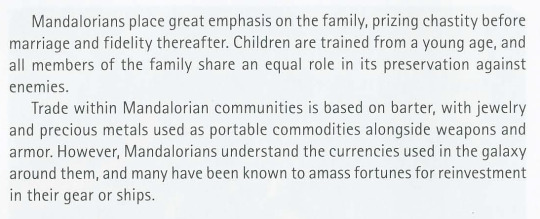
Mandalorians place great emphasis on the family, prizing chastity before marriage and fidelity thereafter. Children are trained from a young age, and all members of the family share an equal role in its preservation against enemies
and The Old Republic Encyclopedia (2012):

CLAN SOCIETY Mandalorian society operates with a minimal and largely informal power structure. Every Mandalorian is a member of a clan, either by birth or recruitment. Although different clans often disagree and even fight one another, they treat their own members like family, regardless of whether they’re related by blood ties or oath. Other than the clan chieftain, members have no official ranks or positions unless organized into a fighting unit where chain of command has a valuable place. Each man or woman is expected to contribute however they can, with those who achieve great things gaining increased respect and new responsibilities. Although clans may have ties or rivalries with other clans, there is no formal hierarchy. All chieftains report directly to the Mandalore The families of Mandalorians are close-knit and remarkably affectionate, despite the culture’s propensity for violence. Marriage is considered a lifelong commitment, and both biological and adopted children are raised with equal love. Sons and daughters are raised as warriors, as gender has little bearing in Mandalorian culture, so much their language hardly distinguishes between male and female.
If the Mandalorians in the twilight of Taung hegemony and relatively shortly after their extinction are presented as those who treat their sons and daughters as equally valued members of the community, then we should ask what caused such discord between this image and the one presented in Mandalorians: People and Culture. If we agree that the term of traditional Mandalorians from mentioned article is not about people from Sith Wars - Mandalorians Wars era and following conflicts but about those between the ancient and modern times, then once again we must determine how much the values of the original Mandalorians have been distorted through the millennia and how trustworthy is our narrator.
As the sources of widely understood lore were examined, let’s look again at the “traditional” afterlife and Mandalorian gods involved with the creation myth. As the article proclaims, “every Mando warrior who dies is said to add to the army of the afterlife”, thus we should assume it includes warriors of all genders. But then the army’s purpose is “defending wives and children living in its permanent, peaceful homestead” yet there is no information against whom the presumably non-combatant inhabitants must be defended. If said army takes part in the eternal conflict between Death and Life, an army of dead wouldn’t then serve Arasuum rather than Kad Ha’rangir, whose connection is to life and change?
There is no explanation why only wives and children are excluded, since children were meant to learn the art of war from their parents, thus logically should join their family in the ongoing battle from age of 8. We should also ask what about professions like blacksmiths or farmers who in life provided vital support for the army by making armors and weapons or producing food. Are they too enrolled into the army of the afterlife if they weren’t nomadic warriors or professional soldiers or allowed to stay in a peaceful homestead? What about those who never could become warriors due to physical or mental illness? Or the same-sex couples with their children? Article described afterlife as the “plane of spiritual energy”, but there is a gender division (women staying in safe homestead), age division (adults and children) and profession division (warriors and non-combatants/mothers/wives), wouldn’t that suggest that Mandalorians at some point believed that afterlife will to some degree mirror their mortal life? If the family bonds stay the same (marriage even in the death and children to take care of), it is not so difficult to imagine the army’s need for armor, weapons, maybe even food and clothes to continue the eternal battle.
Going further with that thought, Arasuum is the one that “remains the same”, while article adds “sloth-god, the personification of idle consumption” and the homestead located in afterlife is described as “permanent” and “peaceful” while the role of Kad Ha’rangir - the Destructor - is definitely much more aggressive in nature. I believe this could reflect the belief that life is a constant battle and struggle that every person at some point will lose, while death is the non-transitory state of existence that offers both a place of peace and an eternal army to join, thus fulfilling the religious purpose Mandalorians dedicated their life to.
Thus Kad Ha’rangir and Arasuum ties to each other may be more complex than we are led to believe because the sense of original mythology either got lost or has changed with Mandalorians over the millenia. Which is why I believe that Arasuum as sloth-god may be an effect of misinterpretation of modern Mandalorians who are disconnected from the original faith of Mandalorian!Taungs as they rejected religious fanaticism and worship of their predecessors.
It won't be an exaggeration to say that the Mandalorians: People and Culture is an important source that both helped popularize modern Mandalorians in star wars fandom during Prequels era and served as an useful introduction to their culture. However, from the perspective of widely understood lore and passing time, this article does not reflect the complexity of Mandalorian culture nor its religion. Arasuum and his opponent, Kad Ha’rangir, is only briefly introduced here but this introduction will influence other authors' take on mandalorian religion.
And those additional tie-in material will be the subject of the next part.
SIDENOTES:
[1] Karen Traviss popularized Mandalorians, however this faction was already expanded by tie-in materials in the past beyond Boba Fett’s character. Other Mandalorian human people for the first time were introduced in Star Wars 68: The Search Begins (1982), while the ancient Mandalorians (Taungs) came to life in The Sith War comics (1995), as part of Tales of the Jedi series. The game Knights of the Old Republic (2003) exploited Mandalorian Wars, and the post-war era, when Taungs died out and their legacy was passed on to the humans. Jaster Mereel’s True Mandalorians and Tor Vizsla’s Death Watch were introduced into lore in 2002, as a way to expand Jango Fett’s backstory for Attack of the Clones film, while the Death Watch name alone has been part of lore since 1989(!). Finally, the Republic Commando book series shaped and popularized the modern Mandalorians (2005-2009), before The Clone Wars animated series (2008-2020) explored the conflict between Death Watch and New Mandalorian, followed by animated TV series Rebels (2014-2018) and Disney made a whole mandalorian-focused TV series (2019-present day).
[2] It is worth keeping in mind that all information about Jaster and Tor’s ideology comes from Count Dooku’s narration. Death Watch has never stated their goals in the comics alone, while Dooku’s opinions were based on information delivered by Jaster & Jango’s allies (including Silas, True Mandalorian tortured by the Sith Lord for information about Jaster’s death). So though Jango Fett: Open Seasons with no doubt is not an objective in its narratives, it gives some credibility to Dooku’s claim about Jaster and True Mandalorians as he sought out Fett's allies in his research about Jango’s past.
[3] dar’manda means a state of not being Mandalorian - a person that is not an outsider, but one who has lost or given up on their heritage, mandalorian identity and the soul.
[4] The dialect was first presented in The Cestus Deception book (2004) as a Mandalorian language but Guide to the Grand Army of the Republic by Karen Traviss and Ryan Kaufman published in Star Wars Insider #84 (september 2005) retconned it as a separate dialect. The “mistake” made in the book is however easy to explain - Sheeka Tull knew Jango Fett personally, after he freed himself from slavery but between he went full into the bounty hunting profession. As she herself was not a Mandalorian and she and Jango met in the Meridian sector, she could mistake Jango’s native language for the mando’a. Fett, as a person born and raised on Concord Dawn could even mix his native language with mando’a. Understandably, Sheeka couldn’t see the difference if she had no other ties to mandalorian culture than one year of dating (post-Galidraan) Jango Fett.
[5] The Behind the Scenes section of wookiepedia’s page for Concordia dialect states that:
At least one Concordian phrase from "The Mandalore Plot"—specifically the line exclaimed by the Death Watch bomber before leaping to his death, and featured as this article's main quote—appears to have been drawn from a 2007 post on the Empire at War forum, in which a user had compiled a list of fanon words and translations for the fledgling Mandalorian language. The aforementioned quote, "Calhava bru'chun dralshye'ran," was translated in the post as "Compassionate leaders will burn." Although the translation would seem contextually appropriate to the episode's storyline, to date there has been no official confirmation that this is the canonically accepted translation.
[6] The part of article focused on language acknowledged the similarity between mando'a and the language of the Taung "from whom the original inhabitations of Mandalore were thought to be descended", yet still does call mando'a origins as unclear.

[7] There is a visible difference between ancient and modern Mandalorians in regard to their dead. Ancient Mandalorians took time to perform proper funeral rites for warriors killed in fight and even have special Death Ceremony for the most brave while modern people have less strict approach. Partially due to the nature of mercenary work (when sometimes the body of fallen comrade could not be brought back to home) and partially due to believing in Manda, in which soul is more important than the body.
[8] The presented idea of Mandalorian fathers training sons may in fact be based on Attack of the Clones Visual Guide (2002) and not be Karen Taviss' own invention. I think the presented informations in her article could be an attempt to keep lore intact. Below the AotC Visual Guide's description for comparison:
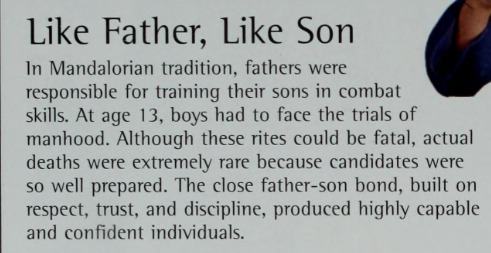
Like Father, Like Son In Mandalorian tradition, fathers were responsible for training their sons in combat skills. At age 13, boys had to face the trials of manhood. Although these rites could be fatal, actual deaths were extremely rare because candidates were so well prepared. The close father-son bond, built on respect, trust, and discipline, produced highly capable and confident individuals.
[9] The presented frame with Ko Sornell's family forgot include the small baby presented in issue #2 (the frames as reference were included in the analysis). Considering the mentioned baby and how the daughter is much smaller than the son at least in the one frame we see the kids close-up,

I think it is safe to assume there were two younger children most likely left under father's care while Ko Sornell was raiding the basilisk droid with her son (and three kids to take care of when Ko was far away for at least few days).
#star wars#cienie's take on mandalorian culture#arasuum#kad ha'rangir#mandalorian culture#mandalorian religion#I’m fully aware that Mandalorians: People and Culture (2006) predates a great number of tie-in material. that expanded our knowledge about#but it was important to establish how outdated the article is from the perspective of time.#i tend to see M:PaC as a good start into basic idea of culture but told from the perspective of modern mandalorians#while the knowledge about ancient times may be misinterpreted by “modern narrator”#also trust me to write a long post and add another wall of sidenotes lol#i know i'm pretty critical to KT's take on gender norms and some aspect of mando culture but the focus on father-son bonds#may be in fact influenced by earlier estabilished informations#but then taungs are pretty much ignored by the author when the religion definitely was affected by taungs
5 notes
·
View notes
Text
Cienie's Star Wars sidenotes
While doing research and writing down the last pieces of Funeral Rites of the Clone Troopers, it became even more clear how The Clone Wars animated TV series did a great disservice to Jedi, especially in the context of medical care for clones.
TCW has clone medics, both as part of combat units (e.g. Kix from 501st Legion) and working apparently in the medcentre as sometimes was presented on the screen.

The role of doctors treating wounded troopers was given to Kaminoans (Nala Se) and droids and sure, those two groups were part of the whole GAR’s medical system in the Legends too. However Jedi Healers (doctors), as far as I remember, were seen treating mainly other Jedi like Yoda
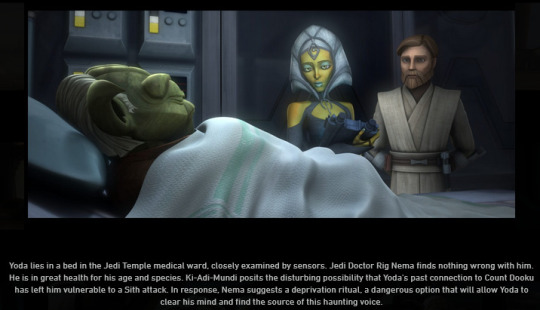
and even then TCW barely paid attention to force healing as an important skill.
The research about medical care for clones gives a pretty drastic idea of what was happening during and after battle which is understandable why the show destined for younger viewers didn’t go into full details about triage of wounded but considering how many dark themes were put in the same show, I dare to say not showing medical care provided by Jedi or common Republic doctors and nurses (who btw are a rare example of republic citizens conscripted into army during the war) actually is unfair. The show reduced one very important aspect of Jedi - they weren’t just generals and commanders either sending or leading troops into battle, they also provided medical help, whether they were specifically trained at healing or not.
In Legends, we could see Jedi Healers assisting the army on various occassions, working in triage area like in Republic comics series:
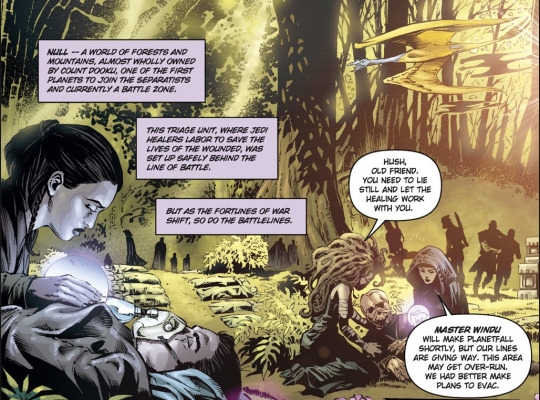
The triage unit, where Jedi healers labor to save the lives of the wounded, was set up safely behind the line of battle. But as the fortunes of war shift, so do the battlelines.
and worrying first about wounded even in the face of serious danger

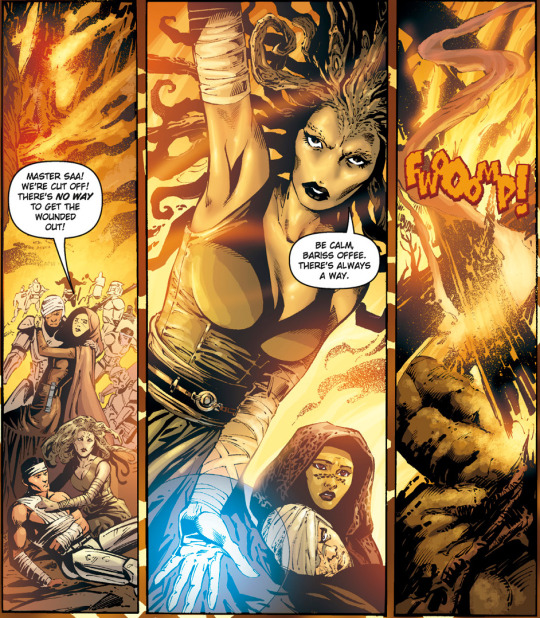
Master Saa! We’re cut off! There’s no way to get the wounded out!
and searching for survivors
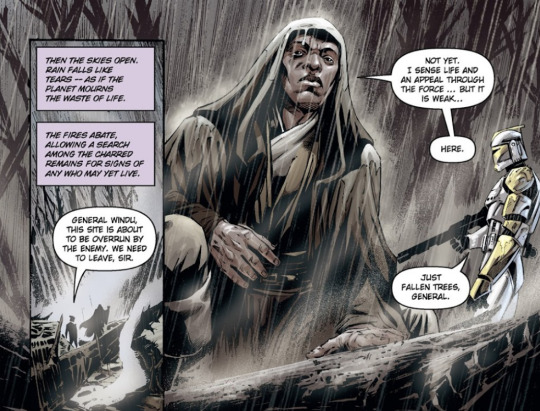
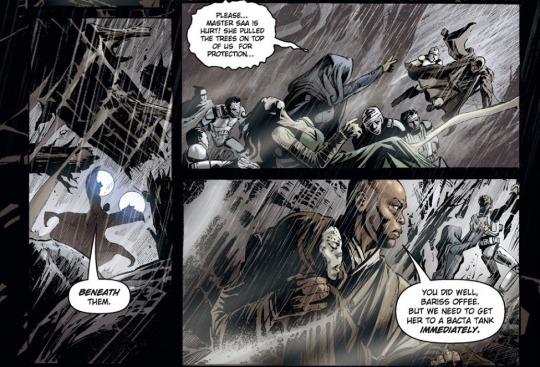
Master Saa is hurt! She pulled the trees on top of us for protection...
and working in hospitals
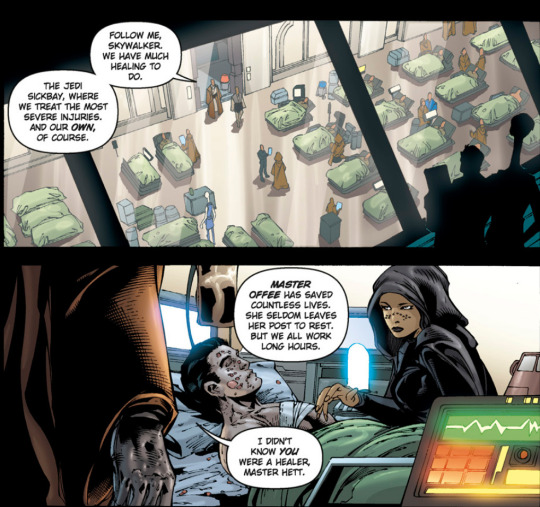
Follow me Skywalker. We have much healing to do. The Jedi sickbay, where we treat the most severe injuries. And our own, of course. Master Offee has saved countless lives. She seldom leaves her post to rest. But we all work long hours.
Not to mention the whole Medstar duology dedicated to padawan Bariss Offee, doctors and nurses serving in Republic mobile hospitals close to frontine - and yes, forever I’m gonna be bitter about how TCW/New Canon treated the most iconic Jedi Healer.
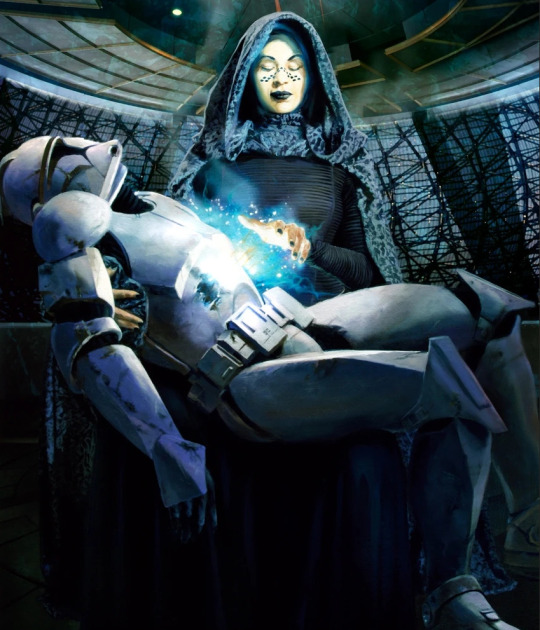
(The cover art for Medstar: Jedi Healer by Dave Seeley)
When padawan Skywalker arrived at New Holstice with his troops, he was immedialy called to assist in the nearest sickbay
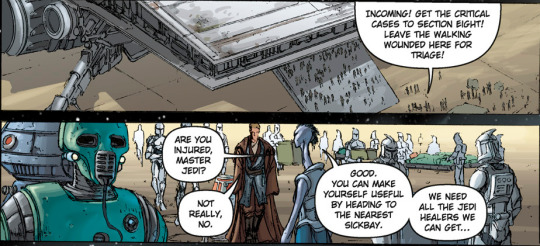
“Are you injured, master Jedi?”
“Not really, no.”
“Good. You can make yourself useful by heading to the nearest sickbay. We need all the Jedi healers we can get...”
and for context, this is Anakin two days after after Jabiim, one of the worst war campaigns Republic experienced so far, the solely survivor of Jedi Pack traumatized both by the loss of his comrades and what happened on the planet and forced to make a devastating choice is literally told to get at work ASAP because every Jedi in between assignment was working here hard to heal the most wounded..
Though no healer himself, Anakin even force-healed injured trooper on battlefield to stop him going into shock:
Supporting the commando trooper with his left arm, Anakin warded off blaster bolts on the run. The rest of Squad Seven supplied cover, blowing STAPs out the sky with uninterrupted fire. Cody motioned everyone into a shallow irrigation trench just short of the mound. By the time Obi-Wan arrived, the troopers were deployed in a circle, and continuing to pour fire into the sky. Anakin slid into the trench a moment later, lowering the commando gently to the muddy slope. Squad Seven’s medical specialist crawled over, removing the commando’s ravaged utility belt and deeply dented helmet. [...]
The harvester’s pincers had crushed the armor into the commando’s abdomen. His skin was intact, but the bruising was severe. With only half the original army of 1.2 million in fighting shape, the life of every clone was vital. Blood and replacement organs - - what the regular troopers referred to as “spare parts” - - were readily available - - “easily requisitioned” - - but with the war reaching a crescendo, battlefield casualties were on the rise and treated as high priority.
“Not much I can do for him here,” the medspec told Anakin. “Maybe if we can get an FX-Seven air-dropped - - ”
“We don’t need a droid,” Anakin interrupted. Kneeling, he placed his hands on the injured commando’s abdomen and used a Jedi healing technique to keep the clone from going into deep shock. [Labyrinth Of Evil]
(and included request for evacuation of the wounded trooper when Cody called for artillery support)
In Republic comics series alone we could see Jedi showing concern for the wounded troopers at various moments, putting their well-being as priority:
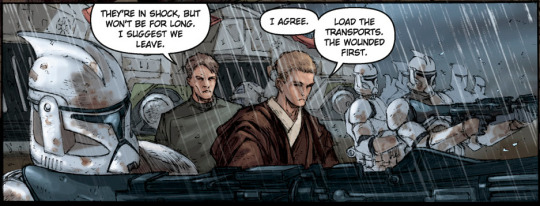
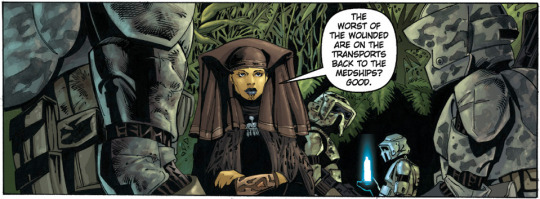
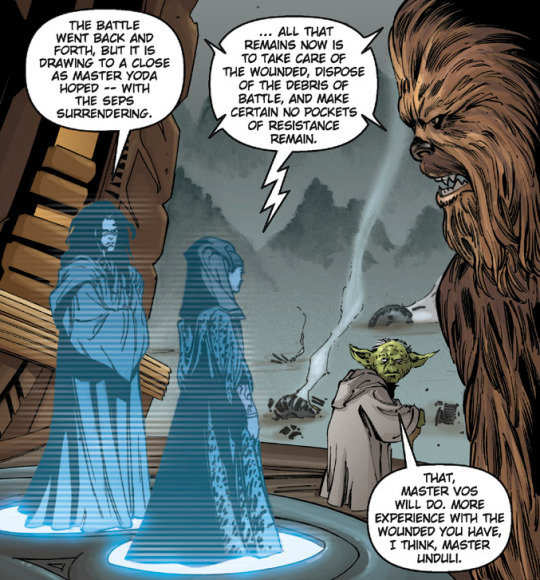
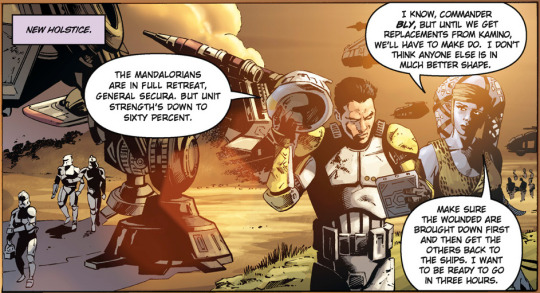
or helping (healing) wounded enemies:
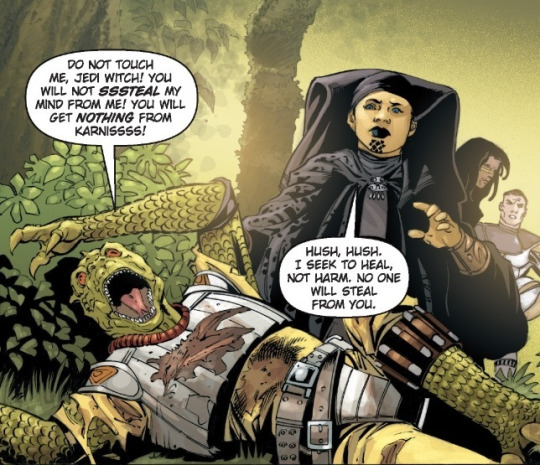
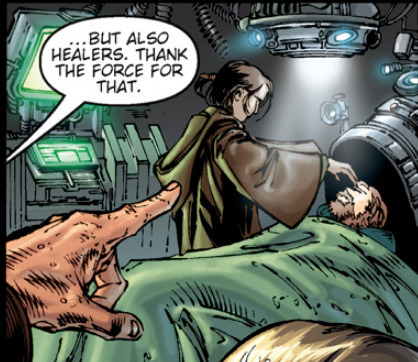
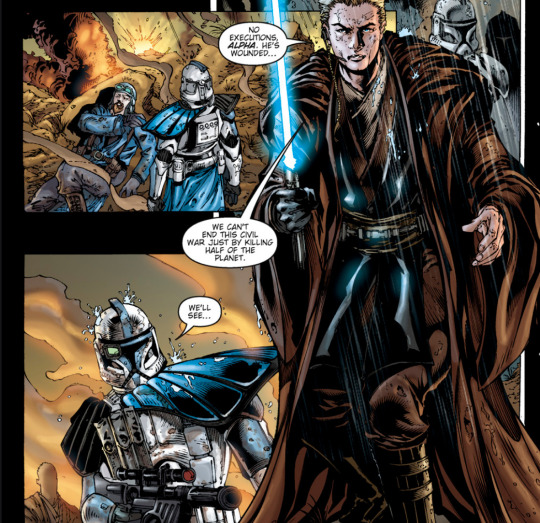
And I won't lie, it is frustrating how Legends, especially Republic comics series that had around 40 issues put so much pressure on Jedi Force healing and how Jedi care for wounded troopers while The Clone Wars (New Canon) that lasted for decade or so kinda ignored the issue? Which is unfair to Jedi and clones alike. The first are presented as less caring, at times indifferent? the latter deserved to have all the available medical help, not just Kaminoans and droids.
#star wars#jedi#jedi healers#clone troopers#legends vs new canon#anakin skywalker#luminara unduli#bariss offee#aayla secura#mace windu#i wil be bitter forever for how tcw treated bariss offee#i demand new canon to bring back the jedi force healing their troopers and wounded in general
601 notes
·
View notes
Photo
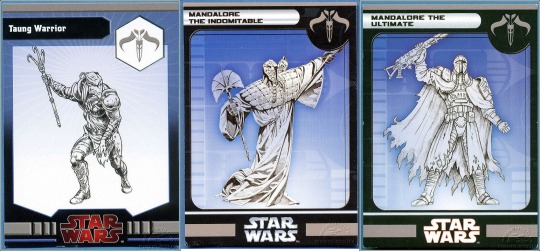
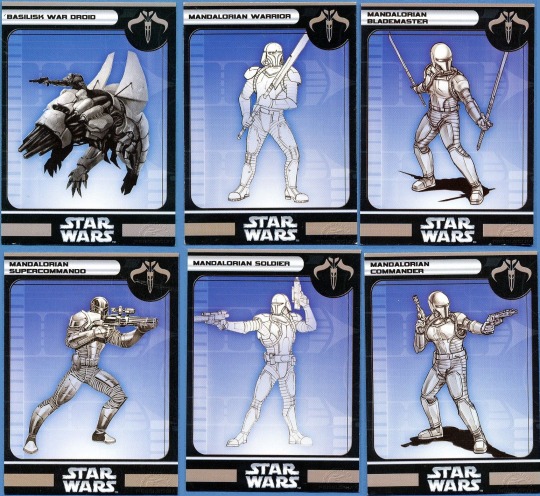

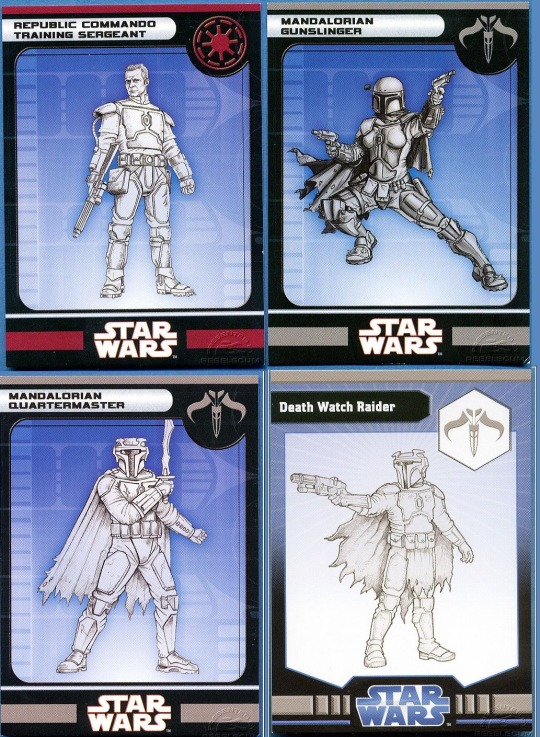
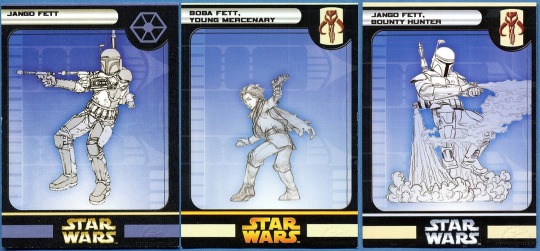
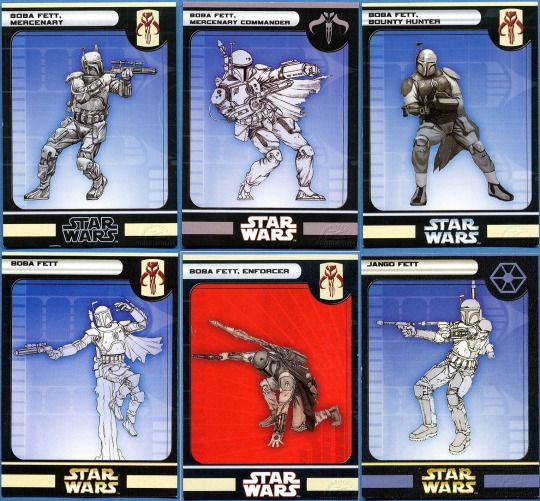
Sidenotes to my larger project Cienie's take on Mandalorian culture. Gathering evidence on the cult of Kad Ha'rangir and the correlation between the Mandalorian warriors (their biological species) and the melee weapons. Source: Star Wars Mandalorian Miniatures by Wizards of the Coast (2004 - 2010)
ANCIENT TIMES
Set 1 (Taungs): Taung warrior, Mandalore the Indomitable, Mandalore the Ultimate
-> Taung warrior is most likely to represent pre-Mandalorian culture as the character lacks an armor, Indomitable has a mythosaur ax (Sith War era), Ultimate carries blaster (Mandalorian Wars era)
Set 2: Mandalorians from Bounty Hunter set (2006).
-> No named characters but additional quotes from their cards and being included with Mandalore the Indomitable & basilisk war droid without Neo-Crusader rider strongly imply the Sith War era.
-> Mandalorian warrior and Blademaster carry a melee weapons. Are they Taung!Mandalorians or humans, there is no way to deduce for sure. KotOR Campaign Guide says human warriors already were part of Mandalorian army during Sith War era.
Set 3: Neo-Crusaders and Ordo Canderous + plus Mandalorian Commander I forgot to add (Mandalorian Wars and post-Mandalorian Wars / Knights of the Old Republic era)
-> Canderous Ordo carry no traditional mythosaur ax nor sword, just blaster
-> there is no way to tell for sure who is under the helmet, but during the Mandalorian Wars humans became a common sight between Mandalorians warriors as Taung species were dying out already. However the armor strongly implies Neo-Crusaders movement thus there is a great chance those figures are in fact humans.
-> Mandalorian Jedi Hunter (from Dark Times set) has an additional description: “Some of the scattered survivors of the Mandalorian Wars seek out Jedi to punish for their humiliation.” There weren’t that many Taung!Mandalorians after the war, so the chance of human/non-Taung character increases.
MODERN TIMES
Set 4: Modern Mandalorians
-> Republic Commando Training Sergeant - based on Kal Skirata, Republic Comics series.
-> Mandalorian Gunslinger - based on Rav Bralor, Republic Commando (according to RebelScum.com)
-> Death Watch Raider’s description “ The Death Watch was a violent splinter group of mercenaries who disagreed with Mandalore Jaster Mereel's insistence on honorable behavior. “[EU set] confirms the modern times (pre-Clone Wars era). During that conflict, as far as sources showed, Mandalorians were presented solely as humans. Thus Mandalorian Quartermaster is most likely a human warrior. From modern times, this one character is presented with a traditional melee weapon (sword).
Set 5: Jango Fett and young Boba
-> No traditional weapon.
Set 6: Boba Fett from various miniatures sets.
-> No traditional weapon.
My observations so far:
-> Between the presented miniatures, the mythosaur ax was used only by Taung!Mandalorian, no human carried such a weapon regardless of era. There is a possibility that mythosaur axes were also a position/ability indicator, similar to Jaing eyes, maybe? Just a thought for further consideration.
-> Mandalorian Warrior, Blademaster and Marauder may be Taungs or may be human/aliens, impossible to confirm. However, Jedi Hunter’s card suggests a post-Mandalorian Wars timeline, and so chances for a Taung character are smaller. Due to Death Watch armor typical for Tor Vizsla & Jaster Mereel’s times, Quartermaster also seems to represent the era in which Taungs are extinct.
-> Miniatures presents Death Watch as a more traditional type of Mandalorians, as Jango and his side of modern Mandalorians (Boba, Republic Commando training sergeant [Kal Skirata] and Gunslinger [Rav Bralor]) uses solely advanced technology & firearms.
Sources of pictures/knowledge: Rebelscum.com, [Polish site] Manda’yaim.
#star wars#star wars miniatures#mandalorians#mandalorian culture#cienie's take on mandalorian culture#cienie's research
27 notes
·
View notes
Text
Mandalorians and melee weapons according to characters stats [KotOR Campaign Guide]
Sidenotes to my larger project Cienie's take on Mandalorian culture. Gathering evidences on cult of Kad Ha'rangir and the correlation between the Mandalorian warriors (their biological species) and the melee weapons used during the Mandalorian Wars. Source: Knights of the Old Republic Campaign Guide [Star Wars Roleplaying Game], 2008.
Mandalore the Indomitable (Taung)
marked as Near-Human
malee weapon / possession: Mythosaur axe, spear

Mandalore the Ultimate
not specified as Near Human (the KotOR campaing guide states his origin is unknown yet most sources usually refer to the Ultimate as Taung)
malee weapon / possession: cortosis Mythosaur axe

Canderous Ordo
human
malee weapon / possession: dagger gauntlet

Cassus Fett
human
malee weapon / possession: none listed

Demagol
species non-specified (Zeltron in theKotOR comics)
malee weapon / possession: knife

Rohlan Dyre
human
malee weapon / possession: knife

Bednak Starkiller
human
malee weapon / possession: none

Mandalorian Crusader
human
malee weapon / possession: knife, mace

Mandalorian Neo-Crusader Marshal
human
malee weapon / possession: bayonet, dagger

Mandalorian Neo-Crusader Soldier
human
malee weapon / possession: mace

Mandalorian Neo-Crusader Shock Trooper
human
malee weapon / possession: vibrodagger, vibroblade

Mandalorian Neo-Crusader Rally Master
human
malee weapon / possession: knife

Taungs: Mythosaur axe
Humans: varies, either unarmed (not listed weapon), mace, knife, vibroblade, vibrodagger, dagger or bayonet
#star wars#cienie's take on mandalorian culture#cienie's research#mandalorian culture#mandalorians#so far no human mando got mythosaur axe
11 notes
·
View notes